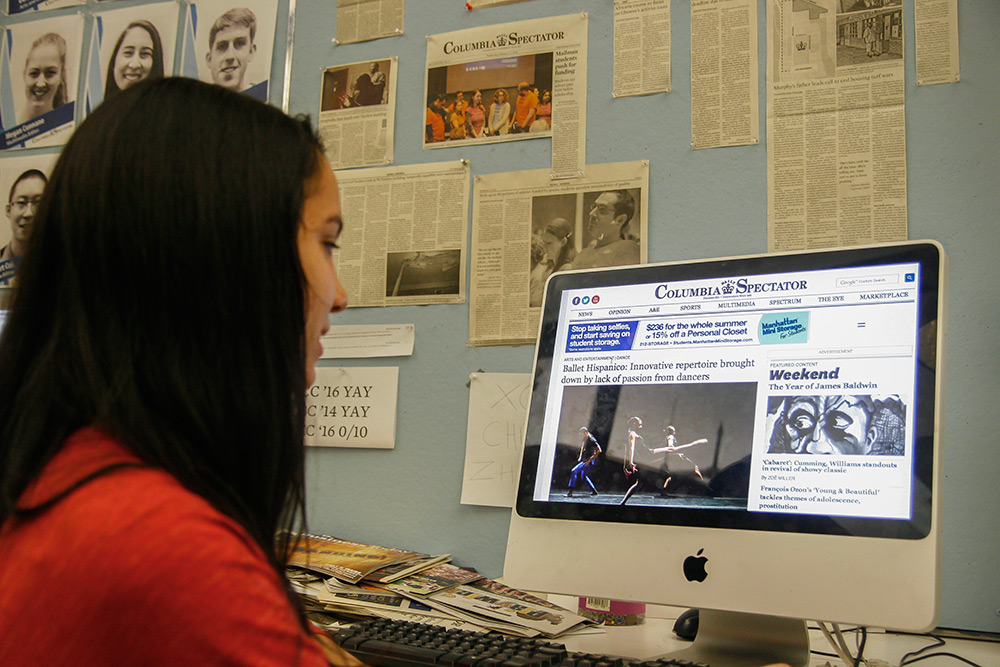
The Columbia Daily Spectator, the student-run newspaper at Columbia University, will switch to a weekly print format in September, making it the first Ivy League school to discontinue a daily print edition.
The 137-year-old print paper will publish every Thursday, allowing the staff to go “web-first” and enhance the quality of the content as well as the overall experience of the online reader, according to editor-in-chief Abby Abrams.
The newspaper’s board of alumni trustees approved the change on Sunday after voting 7-4 in favor of the switch. The vote clearly signaled some opposition to the proposed cutback in the print edition, but the editor-in- chief said she is “incredibly excited” about the change.
Instead of spending nights laying out the paper, Abrams said, “We will have more time to send out reporters to find the big stories that we want to be able to tell, discuss how we want to present these stories online and create really cool and interactive graphics.”
Related story: “College Newspapers Cut Print Editions, Embrace Digital”
The weekly paper, which will be about 12 to 16 pages, will include more in-depth investigative news stories, longer weekend-type arts coverage, as well as interesting commentary pieces, according to Abrams.
Michael Ouimette, the publisher of the Spectator, said that on the business side, they have been preparing for this switch for the last year and a half, given that print advertising has been declining rapidly and the paper was more focused on non-print revenue anyway.
For the first time this year, according to Ouimette, two things have happened at the Spectator: The print product (strictly print revenue versus print cost) has become unprofitable. And non-print revenue sources generated by student businesses have exceeded print revenue.
As far as readership is concerned, Ouimette said that he knows most students aren’t reading the paper in print.
“We see thousands of copies left on the stands every day, versus the 7,000 to 10,000 unique visitors we get on our website every day,” he said.
Due to those factors, the publisher said it became apparent that it was time to slow the presses on the daily print edition: “From a financial perspective, this is a very clear decision.”
Some of the trustees, who are alumni, apparently disagreed and voted against the move. But Ouimette said that he is “very confident” that the changes will bring the Spectator into a new era of higher quality journalism and a much better digital presentation for its readers.
“I understand this is a very nostalgic moment for lots of alumni,” Ouimette said. “However, what matters is providing quality content to readers on the platforms they are using – and that’s digital. That’s really our motivation here.”
Because they have been preparing for this switch for more than a year, Ouimette said the business model will remain the same. Currently, the publication is mostly funded by non-print sources such as sponsored events, donations and a very strong digital advertising network.
Letting go of the unprofitable daily print edition will allow the publication to spend more money on web developers, who can help bring stories to life, as well as into the work-study program, something that staff members feel is highly important.
“I’m very excited about [the work-study program]. It’s something we’ve been wanting to do for a really long time,” Abrams said.
The changes at the Spectator are part of an ongoing trend, as college newspapers follow the lead of many commercial newspapers by embracing web-first strategies to distribute their content and better serve their audience.
“We had to rethink where our audience was, and right now, our audience is mostly mobile,” Jillian Beck, editor-in-chief of the Daily Bruin at UCLA told AJR in November.
Dan Reimold, who covers the student press via his blog, College Media Matters, agrees that this is “absolutely right in line” with the larger trend happening right now within college media.
“I think we’re going to see a ton more of these similar announcements in the months and years to come,” said Reimold.








Leave a Comment